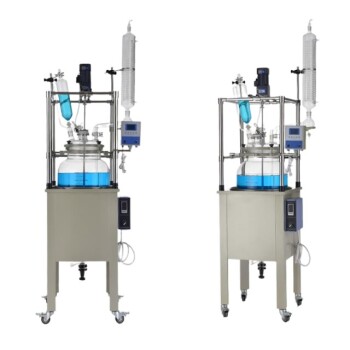A rotary evaporator is a complex piece of laboratory equipment used primarily for solvent removal and distillation. Its design includes several key components that work together to ensure efficient and controlled evaporation. These components include the evaporation flask, vacuum pump, condenser, collection flask, and heating bath, among others. Each part plays a specific role in the process, from rotating the sample to increasing surface area, regulating temperature, and condensing vapors back into liquid form. Understanding these parts and their functions is essential for effective operation and maintenance.
Key Points Explained:

-
Evaporation Flask
- Function: Holds the sample mixture to be distilled or concentrated.
- Design: Typically a round-bottom or eggplant-shaped flask to maximize surface area and ensure even mixing.
- Connection: Attached to the rotor, which rotates the flask to enhance evaporation efficiency.
-
Vacuum Pump
- Function: Reduces pressure within the system, lowering the boiling point of the solvent to facilitate evaporation at lower temperatures.
- Connection: Linked to the condenser and evaporation flask via vacuum tubing.
- Additional Components: May include a bump trap to prevent sample loss due to bumping under vacuum.
-
Condenser
- Function: Cools and condenses evaporated vapors back into liquid form for collection.
-
Types:
- Coil Condenser: Uses a coiled tube through which coolant (e.g., water or refrigerant) passes.
- Cold Finger: A simpler design where a chilled surface condenses vapors.
- Connection: Positioned between the evaporation flask and the collection flask.
-
Collection Flask
- Function: Collects the condensed liquid (distillate) after it passes through the condenser.
- Design: Typically a round-bottom flask or similar container.
- Connection: Located at the end of the condenser system.
-
Heating Bath
- Function: Provides controlled heat to the evaporation flask to facilitate solvent evaporation.
- Design: Often a water bath or oil bath with temperature regulation capabilities.
- Connection: Positioned beneath the evaporation flask, ensuring even heat distribution.
-
Rotor and Motor Unit
- Function: Rotates the evaporation flask to increase the surface area of the sample and promote uniform mixing.
- Design: Includes a motorized mechanism that connects to the flask via a rotor.
- Connection: Linked to the evaporation flask and controlled by the motor unit.
-
Vacuum System
- Function: Maintains the reduced pressure required for efficient evaporation.
- Components: Includes a vacuum pump, vacuum tubing, and sometimes a 3-way piston for pressure control.
- Connection: Integrated with the condenser and evaporation flask.
-
Bump Trap
- Function: Prevents sample loss due to bumping (sudden boiling) under reduced pressure.
- Design: A small chamber or flask placed between the evaporation flask and the condenser.
- Connection: Positioned in-line with the vacuum system.
-
Glass Tube and Vapor Duct
- Function: Protects the sample and aids in the transfer of vapors from the evaporation flask to the condenser.
- Design: Typically made of durable glass to withstand vacuum conditions.
- Connection: Links the evaporation flask to the condenser.
-
3-Way Piston
- Function: Controls the transfer of solvent and regulates pressure within the system.
- Design: A mechanical valve that allows for precise adjustments.
- Connection: Integrated into the vacuum system.
By understanding these components and their roles, users can optimize the operation of a rotary evaporator for various applications, from solvent removal to distillation. Proper maintenance and troubleshooting also become more manageable with this knowledge.
Summary Table:
| Component | Function | Design/Connection |
|---|---|---|
| Evaporation Flask | Holds the sample mixture for distillation or concentration. | Round-bottom or eggplant-shaped flask, attached to the rotor. |
| Vacuum Pump | Reduces pressure to lower the solvent's boiling point. | Linked to the condenser and evaporation flask via vacuum tubing. |
| Condenser | Cools and condenses vapors back into liquid form. | Coil condenser or cold finger design, positioned between evaporation and collection flasks. |
| Collection Flask | Collects the condensed liquid (distillate). | Round-bottom flask, located at the end of the condenser system. |
| Heating Bath | Provides controlled heat for solvent evaporation. | Water or oil bath with temperature regulation, positioned beneath the evaporation flask. |
| Rotor and Motor Unit | Rotates the evaporation flask to increase surface area and promote mixing. | Motorized mechanism connected to the flask via a rotor. |
| Vacuum System | Maintains reduced pressure for efficient evaporation. | Includes vacuum pump, tubing, and sometimes a 3-way piston. |
| Bump Trap | Prevents sample loss due to bumping under reduced pressure. | Small chamber or flask between the evaporation flask and condenser. |
| Glass Tube and Vapor Duct | Protects the sample and aids vapor transfer. | Durable glass tube linking the evaporation flask to the condenser. |
| 3-Way Piston | Controls solvent transfer and regulates pressure. | Mechanical valve integrated into the vacuum system. |
Optimize your lab's solvent removal process with the right rotary evaporator—contact our experts today for personalized advice!















